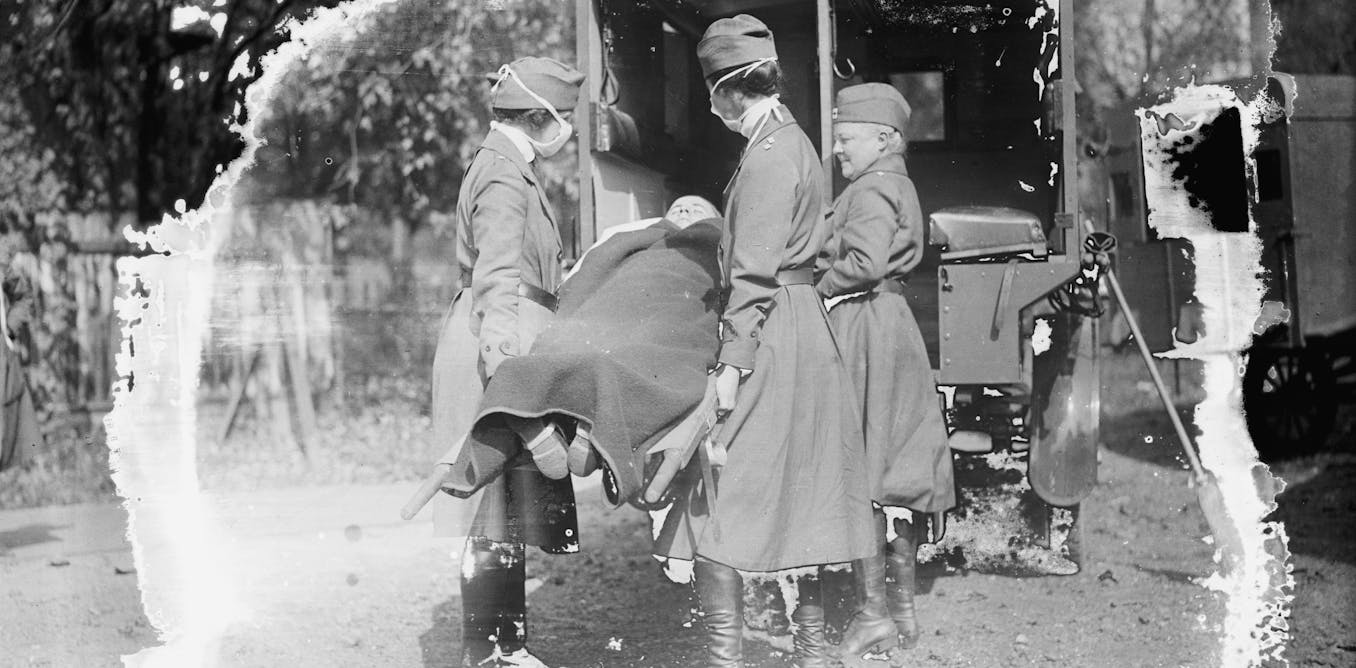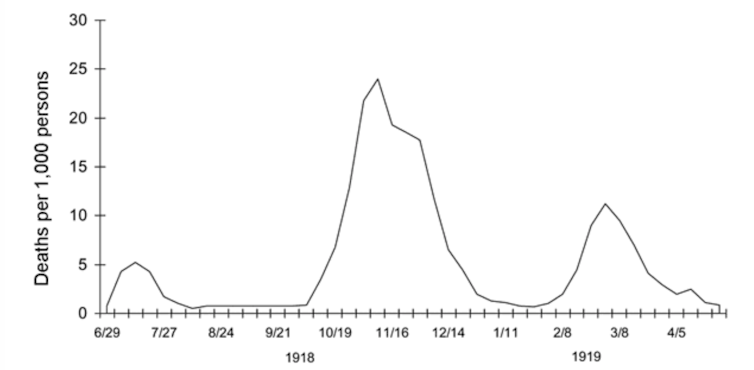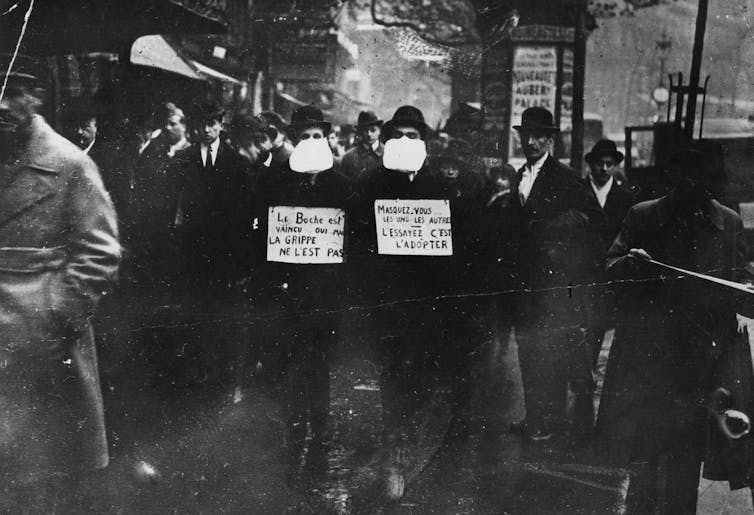“Obey the laws, and wear the gauze. Protect your jaws from septic paws.”
"If you get it, stay at home, rest in bed, keep warm, drink hot drinks and stay quiet until the symptoms are past.""Then continue to be careful, for the greatest danger is from pneumonia or some kindred disease after the influenza is gone."Dr. John Dill Robertson, Chicago health commissioner, 1918
 |
| Volunteer nurses from the American Red Cross tend to influenza patients in the Oakland Municipal Auditorium, used as a temporary hospital, 1918. (Edward A. "Doc" Rogers/Library of Congress via AP) |
"The 1918 flu is still with us, in that sense [that it mutated over time]. It never went away.""Everybody got the flu, and everybody got it bad."Ann Reid, executive director, National Center for Science Education, U.S."There was a very common habit, which has persisted to this day, of blaming an epidemic on one country or one group of people [i.e. 'Spanish' flu].""It goes back centuries."Howard Markel, physician, medical historian, University of Michigan"If introduced in our contemporary world, the influenza strain that caused the 1918 Spanish flu would probably not repeat the same scenario. Autopsy series have revealed that the majority of deaths at any age resulted from bacterial coinfections with common species of the upper respiratory tract, including Streptococcus pneumoniae.""Thus, antibacterial interventions and pneumococcal immunisation have substantially reduced the morbimortality of flu and probably explain the attenuation of influenza pandemic excess mortality during the past century."The Lancet Infectious Diseases
 |
| A pandemic from a century ago doesn’t necessarily chart the course of the pandemic happening now. National Photo Company Collection/Library of Congress Prints and Photographs Division |
Dr.Reid of the National Center for Science Education sequenced the genetic makeup of the 1918 influenza virus in the 1990s; hers is an authoritative voice. Some things are known, other important details remain a mystery as, for example, how and where the 1918 influenza outbreak came into being even though it is conjectured that the novel H1N1 virus passed the species barrier from birds to humans. In 1918 the flu that devastated the world had the capacity to burn through a city or town in mere weeks.
With COVID-19, just like the Spanish flu, no one was immune; in our time, royalty and high-placed political leaders and medical experts alike with the ordinary person on the street contracted the virus. In 1918 Woodrow Wilson was among those who contracted the flu even as he was negotiating the end of the First World War.
The seasonal influenza that we know in our day has a tendency to take the lives of the oldest and youngest in society. Unlike 1918, when roughly fifty percent of those who died represented men and women in their 20s and 30s. "As many as eight to ten percent of all young adults then living may have been killed by the virus", wrote historian John Barry in his book The Great Influenza.
During the First World War 8.5 million soldiers died by warfare. Living quarters helped spread the virus, where soldiers were packed into tight accommodation.
In 1918, Spain, which remained neutral throughout, was the first country to report the presence of the disease, while China, France and the United States because of wartime censorship failed to disclose that they too were facing outbreaks of the disease which became associated with Spain. Alfonso XIII, the king of Spain and elite members of his government also contracted the flu, and the disease was permanently affixed with the Spanish identification.
An epidemiological study cited by historian John Barry noted "the virus was most virulent or most readily communicable when it first reached the state, and thereafter it became generally attenuated." In that the longer the virus existed in specific communities, the less lethal it became. Although the virus was still a threat in 1920, fewer people were dying and scientists of the time began to move their focus to other research, leaving questions about the Spanish flu wide open, unanswered.
 |
In 2009, David Morens and Jeffery Taubenberger, influenza experts from the National Institutes of Health, co-wrote along with National Institute of Allergy and Infectious Diseases Director Anthony Fauci, an article explaining that the descendants of the 1918 influenza virus have contributed to "a pandemic era" that continued for a century. The H1N1 influenza virus was in circulation as a fourth generation descendant of the 1918 virus at the time the article was published.
Noted is that influenza viruses and coronaviruses are different. That being so, very little can be drawn from the influenza experience and knowledge to be applied to COVID-19. "They're really different viruses", stated Paul Offit, director of the Vaccine Education Center at Children's Hospital of Philadelphia. In comparison to the coronavirus, influenza acts consistently and fairly swiftly; people exposed to the flu begin showing symptoms in one to four days following infection.
On the other hand, SARS-CoV-2, the virus that causes COVID, takes five days from infection before symptoms begin showing up; symptom onset ranges from two days to two weeks, evidence that the coronavirus does not move in the same time frame as the 1918 influenza. With the coronavirus, everything is longer; the symptoms, the sickness and the long-term complications, leaving doctors concerned that COVID-19 can lead to lasting cardiovascular complications.
 |

0 Comments:
Post a Comment
<< Home